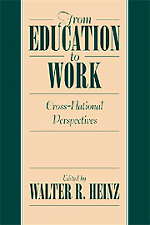Book contents
- Frontmatter
- Contents
- Contributing Authors
- Preface
- Introduction: Transitions to Employment in a Cross-National Perspective
- Part I Social Origin, Gender, and Transition Patterns
- Part II Education and Labour Markets: Work Experiences, Skills, and Credentials
- Part III Changes in the Social Context of Transitions
- References
- Index
Introduction: Transitions to Employment in a Cross-National Perspective
Published online by Cambridge University Press: 30 September 2009
- Frontmatter
- Contents
- Contributing Authors
- Preface
- Introduction: Transitions to Employment in a Cross-National Perspective
- Part I Social Origin, Gender, and Transition Patterns
- Part II Education and Labour Markets: Work Experiences, Skills, and Credentials
- Part III Changes in the Social Context of Transitions
- References
- Index
Summary
In the past, research on school-to-work transitions was focused on specific national issues and educational systems. In recent years, however, it has become obvious that comparative studies are the best and perhaps only way to answer urgent questions about the effects of changes in educational participation and labor-market conditions on the transition to adulthood. Are there general trends in company restructuring and nonstandard forms of work that restrict the life chances of the young generation? How do societies respond differently to the decline of entry-level jobs and the upgrading of skill requirements? To what extent do they rely on market forces or attempt to build institutions that structure and support the transition from school to work for different social groups? Are education and training programs sufficient to integrate disadvantaged and marginalized groups, or do we have to restructure the education and labor-market nexus to not only reduce youth unemployment but also offer equal access to careers and options for combining employment, family work, and further education? Finally, how do young people envision and plan their futures and negotiate transitions from education to the labor market in an era with such an unpredictable future?
When looking at transitions from a comparative perspective, it is necessary to take into account entire educational systems as well as occupational and skill structures as they change in interaction with the decline of the industrial sector and the ascent of the service sector.
- Type
- Chapter
- Information
- From Education to WorkCross National Perspectives, pp. 1 - 22Publisher: Cambridge University PressPrint publication year: 1999
- 5
- Cited by

